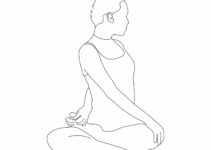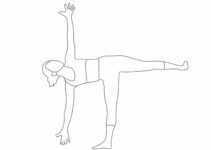
Why Yoga for Diabetes
Yoga is the best cost-effective solution to control and manage diabetes. Yoga acts on diabetes from various fronts. Some yoga poses like Sirsasana, pranayama, and meditation directly work on the pituitary glands and instruct the master glands to work in cohesion with the pancreas. There are yoga asanas, which control the smooth flow of blood. Some yoga poses like Ardha Matsyendrasana, Bhujangasana, Dhanurasana, and Mayurasana directly work for the better health of the pancreas.
Top Yoga asanas for diabetes
1. Sirsasana (Headstand pose: Sirsasana is one of the best yoga poses to manage and control both type 1 & type 2 diabetes. The single yoga pose can handle not only diabetes but also all the hormonal-related problems in the body. The headstand pose enhances the blood flow towards the head region and stimulates the Pituitary gland, a master endocrine gland, to control all the hormonal changes in the body. The secretion of too much diabetogenic hormone due to the master gland leads to type 2 diabetes. It stimulates the islet beta cells of the pancreas to secrete the appropriate quantity of insulin to maintain the optimum glucose level in the body. Knowing its steps is essential to get the best benefits of this asana.
2. Half Spinal Twist Pose (Ardha Matsyendrasana): Ardha Matsyendrasana alternately compressed and stretched the organs, including the pancreas. The thigh pressure against the abdomen partly applies the compression. This gives the organ a good massage, recirculates impure blood, and tones up the pancreas and its associated cells. The cells, significantly the beta one, get activated and help convert glycogen from glucose. The question is how to do the half spinal twist yoga pose, and it is better to know its steps now.
3. Bhujangasana( Cobra pose): Bhujangasana stimulates and massages the pancreas, thus helping in the proper gland functioning. The cobra pose and its variations allow more blood to circulate in the body region, including the pancreas. The increased blood flow makes the organ healthy and enhances its vitality, which further helps in the efficiency of Beta cells. Know the simple steps of how to perform a Cobra pose.
4. Dhanurasana (Bow Pose): The Bow pose toned up the pancreas and stimulates this endocrine gland to secrete the correct amount of glucagon and insulin at the right time. This process helps proper glucose metabolism, thus maintaining the blood’s required sugar levels. I’d like you to please get the details of the steps and technique here.
5. Mayurasana(Peacock asana): The peacock pose is quite effective in controlling and managing sugar in the blood. The advanced yoga asana directly stimulates the metabolic process and gives the diabetic person relief.
How to do Mayurasana
The different simple steps of Mayurasana are given below:
- Sit in Vajrasana. Open the knees and come to the kneeling position by placing the knees on the floor.
- Bend forward, stretch out the fingers of your hands and place the palms on the ground.
- Bend the elbows, keeping forearms together. Place elbows gently on either side of the navel with the chest resting on the back of the upper arms.
- Keep the legs together.
- The body’s weight on the hands and wrists raises the legs from the floor.
- Stretch the head and trunk forward.
- Maintain this position as long as comfortable.
- In the final position, the body remains parallel to the ground with legs stretched out and feet together.
- Come back by lowering the head; place the knees on the floor and the legs on the ground.
6. Surya Namaskar for diabetes prevention
Surya Namaskar(Sun Salutation) harmonises the pancreas, helping remove irregularities by directly massaging the gland and improving its blood flow. The imbalance of it may be caused by tension and stress. Surya Namaskar can help to remove the deeper cause of the hormonal malfunction if other yoga practices supplement it.
7. Yoga Bandha for diabetes
Uddiyan Bandha pulls the abdominal organs inside an upward position, which creates an upward flow of prana. Uddiyan Bandha is suitable for the overall functions of hormonal glands. It improves blood circulation in the trunk and strengthens all internal organs. All abdominal organs are toned, massaged, and maintained, thus helpful in curing diabetes, digestion, constipation, indigestion, etc.
Steps for Uddiyan Bandha
- Sit comfortably in Padmasana
- Place both the palms on the knees.
- Exhale entirely through mouth as well as nose.
- Hold the breath out.
- Pull abdominal muscles up and inside towards the spine.
- Retain the breath outside as long as one can.
- Raise the head.
- Inhale slowly, release the abdominal muscles and return to the normal position.
- Perform 3-4 times initially.
8. Kapalbhati activates the pancreas
Kapalbhati is a breathing exercise known as the frontal brain cleansing process. The powerful breathing yogic exercise can rejuvenate the skull, including the hypothalamus and pituitary gland. It invigorates the entire brain and awakens the dormant centres in the brain. The forced and prolonged exhalation in Kapalbhati increases the decompression of the fluid and expansion of the brain and enhances the massaging effect on the brain. It stimulates nerves in the abdominal region and massages abdominal organs, including the pancreas, thus showing a good impact in managing diabetes.
How to do Kapalbhati
- Sit in a meditative posture with eyes closed
- Inhale deeply through both nostrils, expanding the abdomen, and exhale with a forceful contraction of the abdominal muscles.
- Since now, inhalation is passive and without effort.
- The breathing must be of the bellows’ type.
- Repeat this exercise rapidly several times.
- While doing this exercise, the abdomen should distend and contract.
9. Pranayama for diabetes management
Pranayama regulates the functioning of endocrine glands. Pranayama, when performed with bandhas, governs the functioning of these glands. Pranayama rejuvenates pituitary and pineal glands especially. It activates and invigorates the liver, spleen, pancreas, and abdominal muscles and improves digestion. All the pranayamas directly or indirectly control the functions of the endocrine glands, particularly the pituitary gland. However, the two pranayamas, especially Bhastrika and Anulom Vilom, are very important in managing sugar in the blood. Bhastrika Pranayama( Bellows Pranayama) improves digestion and helps to enhance the body’s overall function.
10. Meditation to reverse diabetes
Meditation aids overall in lessening the signs and symptoms of Diabetes. Meditation is the finest form of relaxation that provides excellent calm, peace, and serenity to the mind, the body and the soul. It is one of the beautiful modalities to control and manage all types of diseases and disorders. It affects the endocrine glands effectively and has a big say on the pituitary gland’s overall function, indirectly regulating the pancreas.






This is a great article. thanks for sharing great information about cure diabetes. i will follow your tips.
Its very usefull for diabetic peolpe and early precautin.